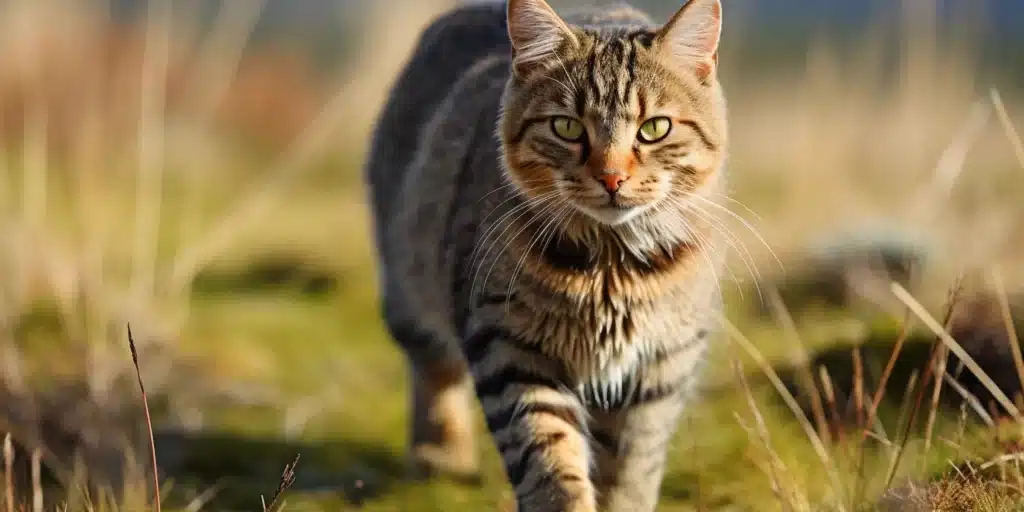When it comes to choosing a feline friend, the differences between male and female cats can sometimes sway potential cat owners in their decisions. Recognizing the nuances can be especially fascinating with unique breeds like the tailless Manx.
The mysterious allure of the Manx cat, with its distinctive round appearance and lack of tail, has captivated cat enthusiasts for centuries.
Originating from the Isle of Man, these charming felines come in both male and female varieties, each with their own set of attributes and idiosyncrasies.
In this blog, we will explore all aspects of “Male vs Female Manx” differences so that by the end, you’ll be better equipped to determine whether a gentleman or lady Manx cat is the right companion for you.

Visual Differences
| Male Manx | Female Manx | |
|---|---|---|
| Average height (adult): | 7 to 11 inches | 7 to 10 inches |
| Average weight (adult): | 10 to 12 pounds | 8 to 10 pounds |
| Lifespan: | 14 – 16 years | 14 – 16 years |
| Exercise: | May require more | Moderate amount |
| Grooming needs: | Possibly more during shedding | Regular grooming |
| Family-friendly: | Very sociable | Equally loving, sometimes cautious |
| Other pet-friendly: | Can be territorial | Generally agreeable if introduced properly |
| Trainability: | Independent, can be trained with patience | Attentive and responsive to training |
Male Breed Overview
Male Manx cats are renowned for their robust and sociable personality. They exhibit a strong presence and often command attention wherever they go. With their playful yet laid-back demeanor, male Manx cats easily become central figures in their human families.
They are known to be affectionate creatures that thrive on interaction and can develop deep bonds with their owners.
The absence of a tail in varying degrees – from a complete lack thereof to a small stub – is a hallmark of the breed and does not significantly differ between males and females.
Training A Male
Training a male Manx can be an enjoyable experience for both the cat and the owner. Males may display more independence and a playful streak that requires patience and positive reinforcement training techniques.
Engaging them with puzzle toys and interactive play sessions can stimulate their natural hunting instincts while also reinforcing desired behaviors.
Consistency is key when training males as they can be quite smart but sometimes prefer to do things their own way.
Health & Care
The robust nature of male Manx cats does not exclude them from the health issues common to the breed. Spina bifida is one such condition to look out for, which is directly linked to the gene that causes their taillessness.
Males need a balanced diet to maintain their weight and prevent obesity, which can be a risk due to their hearty appetites. Regular veterinary check-ups are essential to monitor their health, as with any pet.
Suitable for:
Male Manx cats fit well into various types of homes, from active households to more relaxed settings. They can be great companions for single individuals or families with children due to their affable nature and ability to form strong bonds.
It’s important to remember that while males tend to be sociable, they also need their own space at times and shouldn’t be overwhelmed with attention.

Female Breed Overview
Female Manx cats are usually smaller than their male counterparts but exude a similar level of charm and character.
They may appear more reserved or cautious in new situations but are no less affectionate once they warm up to their human companions.
Females also exhibit the breed’s tendency for strong familial ties and may often become particularly attached to one member of the household.
Training A Female
When it comes to training, female Manx cats might show latent potential due to their observant nature.
They are generally quick learners and can respond well to training if it’s conducted in a calm and non-threatening manner.
They favor routines, and owners should use this trait to their advantage during training sessions. Like males, they respond best when positive methods are applied.
Health & Care
Female Manx cats require attentive care when it comes to their health. Besides watching out for the same genetic conditions that affect males, special attention should be given if they become pregnant due to the potential complications associated with their unique genetic traits.
A nutritious diet tailored to her needs will help keep her healthy throughout her life stages from kittenhood to her senior years.
Suitable for:
The affectionate yet nuanced personality of female Manx cats makes them suitable companions for quieter households or those seeking a less boisterous pet.
They can be particularly good for older individuals or couples seeking a loyal and loving pet with moderate energy levels. Interaction should be on her terms, as females may occasionally demand privacy.
Which One Is Right for You?
Selecting between a male vs female Manx cat ultimately hinges on personal preference and lifestyle compatibility.
If you’re looking for a larger, possibly more active companion who enjoys being the center of attention, a male Manx may be for you.
On the other hand, if you prefer a cat that might be more meticulous with routines and slightly less rambunctious, a female might prove an ideal match.

Conclusion
Choosing between a male vs female Manx cat is not about finding the better sex but rather about finding the perfect personality that blends harmoniously with your own. Both male and female Manx cats have an array of lovable qualities that can brighten up any home.
When deciding which gender is right for you, consider your current living situation, what you look for in a pet, and how much time you’re willing to invest in training and nurturing your furry companion.
With proper care, love, and understanding of the breed’s needs and characteristics, either a male or female Manx cat will make for an extraordinary addition to your life.